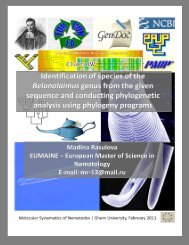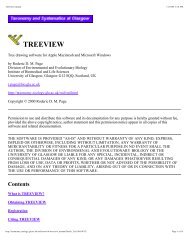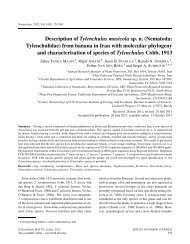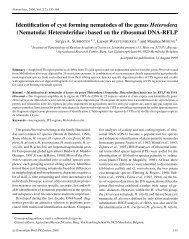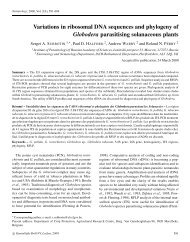Morphological and molecular characterisation of Californian species ...
Morphological and molecular characterisation of Californian species ...
Morphological and molecular characterisation of Californian species ...
Create successful ePaper yourself
Turn your PDF publications into a flip-book with our unique Google optimized e-Paper software.
Studies on Metaporcelaimus<br />
Table 2. Morphometric data <strong>of</strong> female Metaporcelaimus ovogranulosus<br />
sp. n. All measurements are in μm except L in mm,<br />
<strong>and</strong> in the form: mean ± s.d. (range).<br />
Character<br />
El Dorado County<br />
Salix sp. <strong>and</strong> other trees<br />
Holotype<br />
Paratypes<br />
n – 18<br />
L 1.96 1.75 ± 0.12 (1.54-1.96)<br />
a 40 36.2 ± 1.5 (34-39)<br />
b 3.6 3.9± 0.2 (3.6-4.2)<br />
c 49 43.7 ± 3.5 (39-52)<br />
c ′ 1.5 1.5 ± 0.1 (1.4-1.6)<br />
V 51 49.9 ± 0.9 (48-51)<br />
Lip region diam. 19 18.2 ± 0.6 (17-19)<br />
Odontostyle length 18 18.6 ± 0.4 (17-19)<br />
Odontophore length 34 32.9 ± 1.7 (27-35)<br />
Guiding ring from ant. end 8.5 8.7 ± 0.3 (8.0-9.5)<br />
Neck length 539 448 ± 23.0 (415-480)<br />
Pharyngeal expansion length 275 230 ± 13.8 (213-253)<br />
Diam. at neck base 47 45.6 ± 3.7 (38-53)<br />
at mid-body 49 49.0 ± 3.6 (42-56)<br />
at anus 28 26.9 ± 1.6 (24-30)<br />
Prerectum length 79 83.3 ± 32.4 (53-161)<br />
Rectum length 35 32.4 ± 2.2 (27-35)<br />
Tail length 40 40.4 ± 2.6 (35-44)<br />
occasionally visible but poorly developed. Lip region <strong>of</strong>fset<br />
by deep constriction, 2.8-3.1 times as broad as high<br />
<strong>and</strong> one-third to one-half (35-46%) <strong>of</strong> body diam. at neck<br />
base, lips angular <strong>and</strong> moderately separated, labial papillae<br />
slightly protruding. Amphid fovea funnel-shaped, its<br />
aperture 9.0-9.5 μmorca one-half (47-54%) <strong>of</strong> lip region<br />
diam. Cheilostom nearly cylindrical, lacking any differentiation.<br />
Odontostyle typical <strong>of</strong> genus, 4.9-5.4 times as<br />
long as wide, 0.9-1.0 times as long as lip region diam., <strong>and</strong><br />
0.9-1.14% <strong>of</strong> body length, aperture 11-14 μm long or occupying<br />
up to three-fourths (70-74%) its length. Guiding<br />
ring plicate. Odontophore linear, rod-like, 1.5-1.9 odontostyle<br />
lengths long. Anterior region <strong>of</strong> pharynx enlarging<br />
very gradually; basal expansion 6.7-9.1 times as long<br />
as wide, 4.7-5.8 times as long as body diam., occupying<br />
49-53% <strong>of</strong> total neck length, pharyngeal gl<strong>and</strong> nuclei<br />
apparently located as follows: DN = 58-61, DO-DN =<br />
21 μm (n= 1), S 1 N 1 = 64% (n = 1), S 1 N 2 = 71-72%<br />
(n = 3), S 2 N = 86-89% (n = 3). Nerve ring located at<br />
136-161 μm from anterior end or 30-34% <strong>of</strong> total neck<br />
length. Cardia conical, (14-17) × (10-14) μm, its junction<br />
with pharyngeal base surrounded by weak ring-like<br />
structure, visibly asymmetrical as dorsal surface is larger<br />
than ventral, dorsal cellular mass present at level <strong>of</strong> anterior<br />
end <strong>of</strong> intestine in some specimens. Genital system<br />
didelphic-amphidelphic, with both branches equally<br />
<strong>and</strong> moderately developed, anterior 118-229 μm or7-<br />
13% <strong>of</strong> body length (178-261 μm long or 11-14% <strong>of</strong> body<br />
length with an egg inside), <strong>and</strong> posterior 113-190 μm or<br />
7-11% <strong>of</strong> body length (178-253 μm long or 10-13% <strong>of</strong><br />
body length with an egg inside). Ovaries comparatively<br />
large, anterior 64-204 μm <strong>and</strong> posterior 69-239 μm long,<br />
oocytes arranged first in two or more rows, then in a single<br />
row. Oviduct 66-119 μm long or 1.4-2.3 times corresponding<br />
body diam., consisting <strong>of</strong> slender part with prismatic<br />
cells <strong>and</strong> a very poorly developed pars dilatata with<br />
very narrow lumen. Oviduct-uterus junction barely perceptible.<br />
Uterus a simple tube 27-41 μm long or 0.6-0.8<br />
times corresponding body diam. Uterine eggs ovoid, (88-<br />
103) × (33-37) μm, 2.4-2.8 times as long as wide, its shell<br />
bearing small but abundant granular bodies. Vagina extending<br />
inwards 19-24 μm, occupying two-fifths to onehalf<br />
(38-52%) <strong>of</strong> body diam., pars proximalis 11-17 ×<br />
13-19 μm, with somewhat sigmoid walls <strong>and</strong> surrounded<br />
by weak musculature, pars refringens with two adjacent<br />
triangular to rounded pieces measuring (5.5-7.5) × (4-<br />
5) μm, combined width <strong>of</strong> 7.5-10.5 μm, pars distalis 1.5-<br />
2.5 μm long. Vulva a nearly equatorial, transverse slit.<br />
Prerectum 2.0-3.6, rectum 1.0-1.5 anal body diam. long.<br />
Tail conical with rounded tip, ventrally straight, dorsally<br />
convex or with a weak concavity at terminus, inner core<br />
somewhat sunken at both sides <strong>and</strong> forming a digitate,<br />
terminal extension nearly reaching tail tip, hence hyaline<br />
portion <strong>of</strong> tail is very short. Two pairs <strong>of</strong> caudal pores,<br />
subdorsal, at middle <strong>of</strong> tail.<br />
Male<br />
Unknown.<br />
TYPE LOCALITY AND HABITAT<br />
American River Parkway, River Bend Park, El Dorado<br />
County, California, USA, where the new <strong>species</strong> was<br />
collected in association to willow (Salix sp.) <strong>and</strong> other<br />
trees.<br />
TYPE MATERIAL<br />
Female holotype <strong>and</strong> 16 female paratypes deposited in<br />
the nematode collection <strong>of</strong> the University <strong>of</strong> Jaén, Spain.<br />
Two female paratypes deposited with USDA Nematode<br />
Collection, Beltsville, MA, USA.<br />
Vol. 00(0), 2012 11



